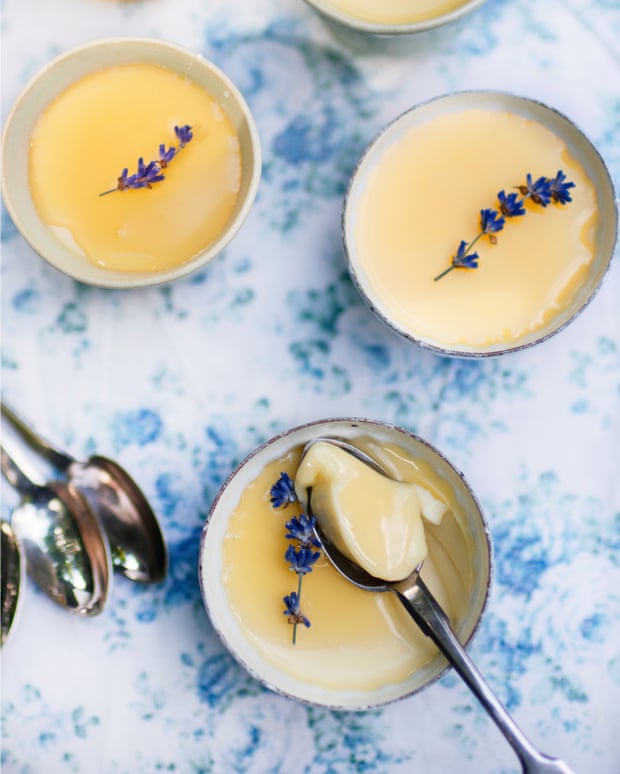
It might be jolly useful to have a summer salad up your sleeve that is both light enough for summer but also substantial – the sort you might bring out with a plate of marinated mozzarella or burrata, a summer terrine of salmon trimmings or perhaps some thick, jagged pieces of roast chicken picked from its bones. A salad that will keep overnight if it has to, and whose presence on the table is unlikely to break the bank.
A green herb tabbouleh fits the bill: a couple of handfuls of grain tossed with twice its volume of very finely chopped parsley, a fist of mint, spring onions and lots of lemon and then a few surprises in the form of neat cubes of avocado and large and peppery basil leaves. When the summer is at its height I will include diced cucumber, too, for a further shot of coolness and bring it to the table with a bowl of crisp, cold lettuce leaves I have soaked in iced water, with which to scoop it up.
We ate such a calm, gentle salad last Sunday afternoon, followed by a plate of flat, white peaches that smelled of rose petals and some tiny pots of panna cotta, almost too soft to turn out. The dessert, set in pale green and white pots, was sweetened with honey and seemed in step with this, the quietest of the season’s lunches, eaten in the presence of slow-moving bees in the nasturtiums. Bees almost too fat to fly.
My cooking has been particularly unhurried this week, the cook moving at a somewhat glacial pace from fridge to stove. This long summer, with its seemingly endless garden breakfasts and surfeit of burrata-led lunches, rather got the better of me.
I turned the oven on only once, to roast a chicken to eat cold. I made a rather lovely butter for it with chopped tarragon and lemon thyme, a pinch of fennel seed and a few beads of dried lavender, which I then weedled softly under its skin with my fingertips.
Cucumber, avocado and basil tabbouleh
Although I would make this no more than an hour or two before eating – lest the avocado brown – it will happily survive a night in the fridge if tightly covered. (We took it on a picnic to Wales and it travelled better than most salads I have known.) The trick as always with tabbouleh is to make it with more herbs than grain, and to be unstinting with the lemon juice.
Serves 4-6
fine bulgur 100g
spring onions 3
cucumber 250g
parsley 80g (weight with stalks)
basil leaves 25g
mint leaves 12, medium
green olives 75g, stoned
lemon 1
avocados 2, medium
olive oil 5 tbsp
Put the fine bulgur in a small bowl, then pour enough cold water over it to cover it by 1cm, and set it aside for 20 minutes while you assemble the salad.
Finely chop the spring onions and put them in a mixing bowl. Peel the cucumber, cut it in half lengthways, then scoop out the wet core and seeds with a teaspoon. Cut the cucumber into small dice and add these to the spring onions.
Remove the parsley leaves from their stalks and finely chop them, then mix them with the spring onions and basil and mint leaves. (You can shred the basil if you like, but I prefer to leave the leaves whole, unless they are particularly large.)
Roughly chop the green olives, then add to the cucumber, onions and herbs. Halve and squeeze the lemon into the salad.
Halve the avocados, remove and discard the stones, cut the fruit into quarters, then peel back and remove the skin. Dice the flesh into small cubes and toss gently, taking care not to crush it, with the other ingredients.
Trickle over the olive oil, then add the drained bulgur and toss everything together gently before piling it on to a serving dish.
Honey panna cotta
After many years of making panna cotta using the classic method, I was intrigued by Skye McAlpine’s idea of sweetening it with honey rather than sugar. I think this is better, the honey adding to the silky quality of the dessert.
Enough for 4-6 small glasses
For the panna cotta:
gelatine 2 leaves
liquid honey 2 tbsp
double cream 350ml
vanilla 1 pod
caster sugar 100g
full-cream milk 150ml
honey a little, to serve
Put the gelatine in a bowl of cold water to soften. Pour the honey and cream into a small nonstick saucepan. Split the vanilla pod in half lengthways and scrape the seeds into the cream. Add the empty vanilla pod and sugar to the pan, then bring to the boil.
Remove the pan from the heat, cover it and leave it to infuse for at least 20 minutes. Re-warm the cream briefly (it doesn’t need to be very hot), then gently squeeze out the water from the softened gelatine and add it to the cream; stir to dissolve it.
Pour the milk into the cream, stir gently, remove the vanilla pod, then pour through a fine sieve placed over a jug.
Pour the mixture into 4 small glasses or cups, place them in the fridge and leave them to set for 4 hours.
Spoon the remaining honey over the surface of the panna cotta and bring it to the table.
Follow Nigel on Twitter @NigelSlater



